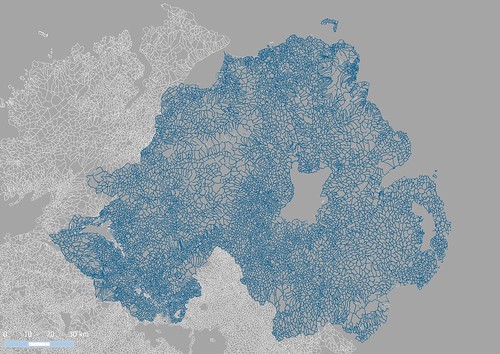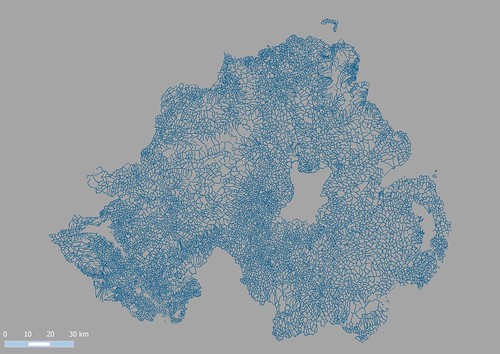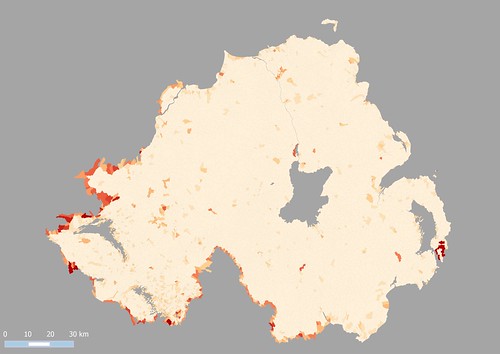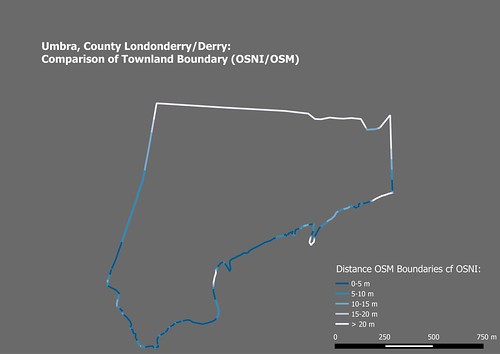 |
| View along N side of MacGilligan Peninsula towards Inishown from Umbra |
My reasons for doing this are not just pure interest. The usefulness of the Irish Vice County boundaries depends of their positional accuracy. Earlier my prediction was that such boundaries ought to be within 10 metres of their true location on the ground where they were based on townland boundaries, but this was largely based on experience with other OSM data rather than an objective statement. Thus investigating the accuracy using an independent data set provides an excellent way of testing this statement. The tests need to be done now, because (as we shall see) the nature of OSM is to fix issues spotted very quickly, and thus datasets become loosely coupled.
I adopted two approaches:
- A straight comparison of areas (or their ratios).
- Using a series of buffered boundaries from one source (OSNI) and seeing what proportion of the other source (OSM) was included in each buffer.
 |
| Northern Ireland using the same colouring. At this scale very few boundary mismatches are apparent. |
Closer inspection (as with the Umbra) shows much of the discrepancy to be present along the coast. This is not surprising, coastlines on OSM were originally derived automatically, and even when refined by hand are unlikely to accord with Mean High Water (MHW). Certainly, for my purposes, it is merely important that the OSM coastlines do not stray above MHW.
 |
| OSM townland Boundaries within 5m of OSNI data |
 |
| Area comparison. Townlands are coloured according to absolute variance of ratio of areas from 1. The redder they are the further the ratio is from 1. |
- Boundary discrepancy (such as coastlines). Mainly caused by coastlines, or difficulty of delineating some boundary feature, such as the course of the Umbra river above)
- Erroneous interpretation of the boundary on old maps causing selection of the wrong feature. This transfers land from one townland to another, therefore these should cluster.
- Missing townlands. When a single townland has been created without noticing one or more others inside it (Town Parks townland at Ballymoney is an example).
- Different treatment of townlands bisected by a Civil Parish. See caption of first image above. Incorrect tagging.
- Higher level administrative units having tags appropriate to a townland. I've noted two cases of this one of which was Ballyphilip CP on the Ards peninsula in County Down.
- Islands. Some offshore islands appear to be missing from the OSNI data (see The Skerries N of Portrush)
To conclude, townland boundaries show exactly the kind of positional accuracy we expected (or perhaps hoped). Perhaps 1% of the total data (90-100 townlands from about 9000) may need some form of correction. I'm biased, but this seems pretty good, for a project principally relying on rectified photo-reduced maps from 1939! It's also worth remembering, that unlike road comparisons, there is no widely available sensor data (ie GPS tracks/point) to help boundary alignments.
When time permits I'll extend this to include OSI Open Data too. A big thanks to both organisations for releasing their Open Data. OSNI staff have been contributors to OSM for a while: they host Missing Maps lunchtime sessions in their offices.



The cluster in the north-east to the east of Coleraine are actually where the townlands are split by a county boundary. OSM nests the townlands within counties; OSNI doesn't because the county boundary is no longer a district boundary.
ReplyDeleteThe townland shapefiles for the two agencies (OSNI and OSi) aren't seamless when it comes to the border which is causing parts of townlands in the Republic to be included in your data set. These discrepancies exist even with the ungeneralised townland boundaries for the Republic.
The OSi open data is generalised to 20m so you may not be able to carry out the analysis to the same degree of accuracy as with the townland boundaries in the North.
Many thanks Paddy. I knew the Coleraine ones were split by a Civic Parish, but am very much looking at the trees not the wood so missed it was on the county boundary.
ReplyDeleteI hadn't got to the bottom of the border issue, so your comment is extremely helpful.
I really should compare border segments rather than complete borders, but this approach was a bit easier to do quickly.
When I do the OSI data I hope it will broadly confirm these findings, even though the boundaries are more generalised. Most useful is to find major discrepancies.
I didn't mention it here, but it is also possible to just get a list of townland names by county from Overpass turbo & compare that with equivalent lists from wikipedia too.
Actually, many of them are in the same civil parish (in that the civil parish is split by the county boundary)
ReplyDeletehttp://maps.osi.ie/publicviewer/#V2,690339,931304,9,7
The Wikipedia lists were scraped from the old Seanruad site (a transcript of the 1851 townland index) and may have errors and omissions as well as including towns and villages as separate entries and not taking account of townlands being subsequently merged or created since 1851.